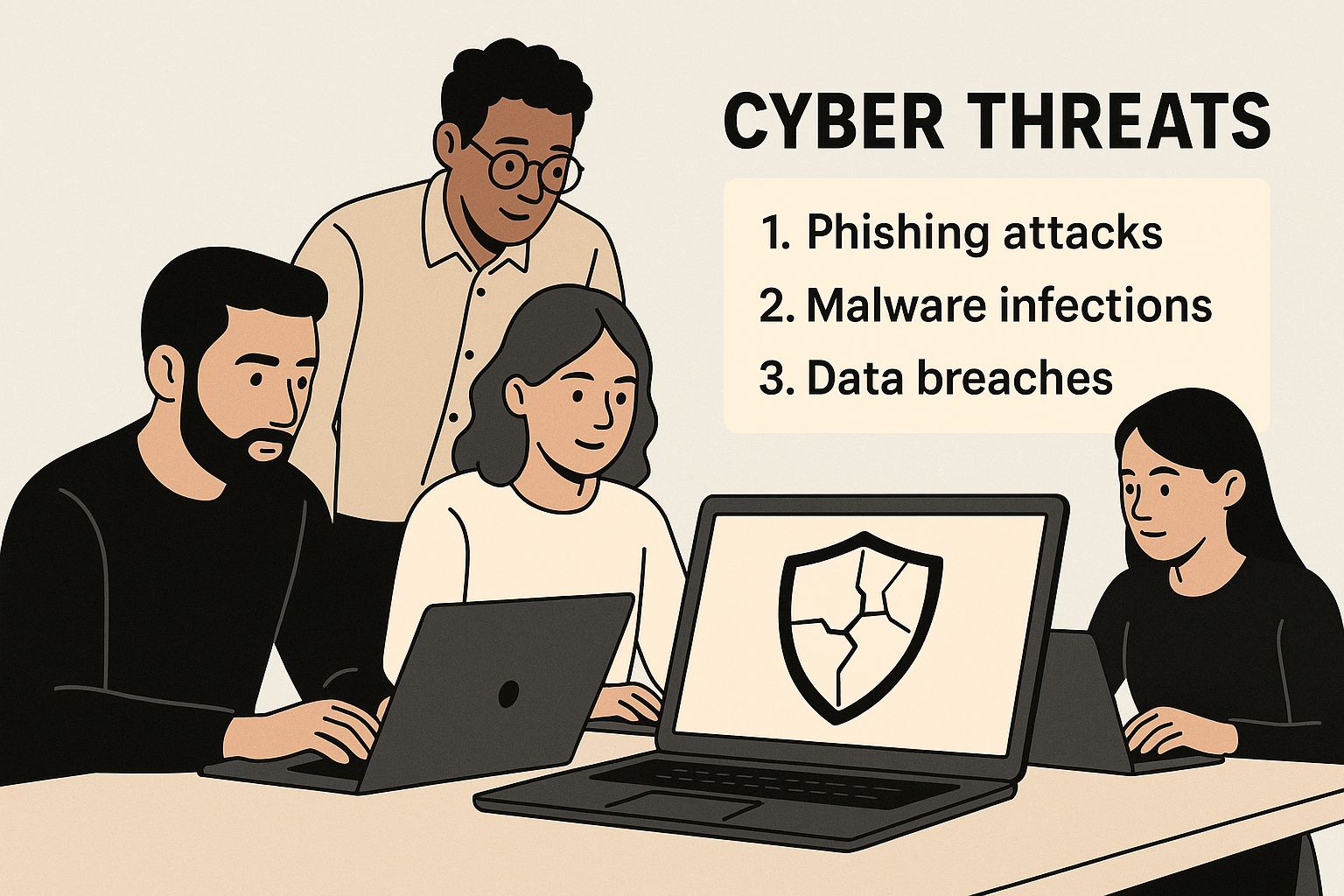Why Startups Can't Afford to Ignore Cybersecurity
Startups are all about innovation and rapid growth. This often means prioritizing product development and getting to market quickly. Sometimes, other important areas, like cybersecurity, get overlooked. However, this can be a risky strategy. Startups, with their valuable data and developing security systems, are often targets for cybercriminals.
The Startup as a Target: Data-Rich, Security-Poor
Cybercriminals know that startups often have valuable intellectual property, customer data, and financial information. At the same time, they may lack the strong security measures of larger companies. This makes them attractive targets. For example, a startup developing new AI technology might be targeted for its algorithms. An e-commerce startup could be vulnerable to customer data theft.
The Devastating Impact of a Breach
The effects of a security breach on a startup can be disastrous. The immediate financial costs of incident response and recovery are just the beginning. Long-term repercussions, such as reputational damage, loss of customer trust, and difficulty attracting investors, can cripple a young company. Startups need to understand the wider impact of digital threats. For more on this, read about the Importance of Digital Security.
The Rising Cost of Cybercrime
The financial costs of cybercrime are increasing rapidly. Global cybersecurity spending is expected to hit $212 billion in 2025, a 15.1% year-over-year increase. In 2024, the average global cost of a data breach was $4.88 million per incident, a 10% increase from the year before. 70% of breaches caused significant operational disruptions. Breaches related to remote work, common for startups, added an average of $173,074 per incident. You can find more detailed statistics here. This shows how critical it is for startups to invest in cybersecurity.
Proactive Security: An Investment, Not an Expense
While the cost of a data breach can be significant, investing in basic cybersecurity from the start is much more cost-effective than dealing with the aftermath of an attack. This proactive approach helps startups build a solid security foundation that grows with the company, protecting valuable assets and building trust with customers and investors. Prioritizing cybersecurity is not simply about reducing risk—it's about ensuring the long-term success of the startup.
Building Maximum Security With Minimum Resources

The infographic above illustrates the cyber threats startups face, visualized as cracks in a security shield on a laptop. This highlights their vulnerability, especially with limited resources. Even small teams using basic technology need to prioritize cybersecurity.
Robust startup security doesn't require a massive budget. Instead, it demands a strategic approach. This means focusing on high-impact measures and understanding security debt. Like financial debt, ignoring early security issues creates bigger, more expensive problems down the line.
Prioritizing Security Investments for Maximum ROI
Prioritizing is critical for startups with tight budgets. Not all security investments offer the same return, especially in the beginning.
-
Multi-Factor Authentication (MFA): MFA is a low-cost, high-impact measure. It adds an extra layer of protection, requiring multiple verification factors and blocking unauthorized access.
-
Strong Password Policies: Enforcing strong, unique passwords is fundamental and cost-effective. This simple practice can prevent a surprising number of security breaches.
-
Regular Software Updates: Keeping software updated is vital for patching vulnerabilities. This proactive approach minimizes exploitation risks.
These foundational steps provide considerable protection without large financial investments. As your startup grows, you can explore more advanced solutions.
To help visualize these priorities, let's look at a helpful comparison:
Startup Security ROI Matrix: Where to Invest First
This table compares essential security measures based on implementation cost, protection strength, and resource requirements to help founders make informed security investments with limited budgets.
| Security Measure | Implementation Cost | Protection Impact | Resource Requirements | Priority Score |
|---|---|---|---|---|
| Multi-Factor Authentication (MFA) | Low | High | Low | High |
| Strong Password Policies | Very Low | Medium | Very Low | High |
| Regular Software Updates | Low | Medium | Low | Medium |
| Data Encryption | Medium | High | Medium | Medium |
| Penetration Testing | High | High | High | Low |
This table demonstrates how foundational measures like MFA and strong passwords offer significant protection for minimal investment. As resources increase, data encryption and penetration testing become viable options.
Understanding Security Debt and Its Implications
Delaying essential security measures accrues security debt. This debt accumulates, becoming harder and costlier to address later. Imagine a startup postponing data encryption. As it grows and collects more sensitive data, breach consequences escalate, increasing remediation costs and damaging reputation. Addressing security early is more economical and effective long-term.
Learning From Experienced CTOs: Practical Security Strategies
Successful startup CTOs have navigated security challenges with limited resources. They stress protecting the most valuable digital assets:
-
Identifying Crown Jewels: Determine your most critical data, systems, and intellectual property.
-
Proportionate Protection: Implement security measures proportionate to each asset's value and sensitivity. This prevents overspending while ensuring adequate protection.
-
Scalable Solutions: Choose solutions that adapt and grow with your startup.
By following these principles, startups build a solid security foundation that scales without straining their budget. This builds trust with customers and investors, fostering long-term success.
Navigating the Hidden Dangers of Third-Party Relationships
Your startup's cybersecurity relies heavily on the strength of every link in its vendor chain. This often-overlooked area is a growing target for cyberattacks. Imagine a medieval castle—even with impenetrable walls, a weakly defended side entrance can offer invaders access. Likewise, strong internal security measures won't protect your startup if a vendor's lax practices create vulnerabilities.
Understanding the Vendor Risk Landscape
Modern startups depend on third-party vendors for a wide range of services, from cloud computing platforms and software to payment processing and marketing automation. This interconnectedness expands your potential attack surface. For instance, a data breach at your email marketing provider could compromise your customer database, while a vulnerability in your payment processor's systems could lead to financial fraud.
This is why managing vendor risk is crucial for startups. Supply chain cyberattacks are on the rise, becoming both more frequent and more sophisticated. In 2024, 183,000 customers worldwide were impacted by these attacks, a 33% year-over-year increase. Gartner predicts that by 2025, 60% of supply chain organizations will prioritize cybersecurity risk when evaluating third-party business transactions. You can find further statistics on cybersecurity here. This data underscores the growing importance of rigorous vendor assessments.
Evaluating Vendor Security
Thorough vendor security evaluations may appear daunting, especially for startups without dedicated risk management teams. However, practical steps can be implemented to mitigate risk.
-
Start with a Questionnaire: A basic security questionnaire can offer valuable insight into a vendor's security posture. Inquire about their data protection policies, incident response plans, and security certifications such as ISO 27001 or SOC 2.
-
Review Their Security Practices: Understand how vendors manage data encryption, access controls, and vulnerability management. Look for evidence of regular security audits, penetration testing, and vulnerability scanning.
-
Contractual Protections: Include specific security requirements and liabilities in your contracts with vendors. Clearly define data protection standards, incident notification procedures, and consequences for non-compliance.
Ongoing Monitoring and Communication
Vendor relationships demand continuous monitoring. Security evaluation isn't a one-time event.
-
Regular Check-ins: Schedule regular meetings with vendors to discuss security updates, emerging threats, and address any concerns. Open communication is essential.
-
Performance Monitoring: Keep track of vendor performance regarding security incidents and identified vulnerabilities. This helps you assess their ongoing commitment to security.
-
Incident Response Planning: Collaborate with key vendors to develop a joint incident response plan. This ensures a coordinated and effective response in the event of a security breach.
By implementing these strategies, startups can effectively navigate vendor risks, safeguarding their valuable assets and building trust with customers and investors. This creates a more secure ecosystem, minimizing the chance of third-party vulnerabilities impacting your business. Balancing the need for rapid partnership development with thorough security due diligence is crucial for sustainable growth.
Building a Security Culture That Doesn’t Slow You Down

Security and innovation can coexist. This isn't about creating impenetrable digital fortresses. It's about fostering a security-conscious environment that becomes integral to your startup’s DNA. This approach, emphasizing education and shared responsibility, empowers growth rather than hindering speed.
Training That Sticks in a Fast-Paced Environment
Traditional security training often falls short in dynamic startup environments. Lengthy modules and abstract threats don't connect with teams driven by rapid development. Short, engaging training focused on practical, real-world scenarios relevant to your startup's daily operations is much more effective.
For instance, training could simulate phishing attacks, teaching employees how to identify and report suspicious emails. Real-world examples of breaches and their impact on similar startups can underscore the importance of vigilance.
Empowering Security Champions Across Teams
Distributing security responsibility reduces the burden on any single individual and embeds security best practices throughout the organization. This is where Security Champions play a vital role. These individuals within each team receive specialized security training, becoming valuable resources for their colleagues.
Security Champions aren't necessarily security experts. Instead, they act as a bridge between the broader security strategy and the team's daily workflow. This approach creates a network of security advocates within the company, cultivating a proactive security culture.
Creating Policies That People Actually Follow
Security policies shouldn't be dense, unread documents. They should be concise, clear, and easily integrated into existing workflows. Short, actionable guidelines focused on key security behaviors are far more effective than complicated rulebooks.
A straightforward policy outlining password requirements and data handling procedures is more likely to be followed than a lengthy document covering every possible scenario. This practical approach ensures security measures are embraced, not ignored. A key component of cybersecurity for startups is building a positive security environment; you can learn more about activities for building a strong security culture.
Incentivizing Secure Behaviors
Positive reinforcement is a powerful driver of adoption. Recognize and reward employees who consistently follow security best practices. This can include acknowledging individuals in company meetings, offering small gifts, or incorporating security metrics into performance reviews.
This approach motivates teams to prioritize security, transforming it from a perceived burden into a positive, shared responsibility. It creates a sense of collective ownership, which ultimately benefits the entire startup.
Building Trust and Competitive Advantage
Integrating security into your company values goes beyond mere compliance. It cultivates a culture of trust, both internally among employees and externally with customers and investors. It demonstrates that the security of employee and customer data is paramount.
In a landscape where security breaches are increasingly common, a robust security posture becomes a significant competitive advantage. It builds confidence and solidifies your reputation as a trustworthy and reliable startup.
Securing Your Development Pipeline Without Killing Speed

Building a secure product doesn't have to mean sacrificing speed. In fact, integrating security from the outset can boost your startup's agility and long-term success. This section explores how to balance these two critical elements. Think of it like building a house: incorporating fire safety during construction is far more efficient than adding it later. Similarly, addressing security throughout the development lifecycle is more effective and less disruptive.
Lightweight Threat Modeling: Identifying Vulnerabilities Early
Threat modeling identifies potential security risks and vulnerabilities early in the design phase. It's about proactively anticipating how attackers might exploit your system, and then designing defenses.
This doesn't require complex processes. Startups can adopt lightweight techniques. For example, a simple brainstorming session with the development team can identify potential attack vectors. This helps prioritize security controls based on the likelihood and impact of different threats.
Automated Security Tools: Enhancing Protection Without Overhead
Automating security tasks frees up developers to focus on building features. Automated tools can scan code for vulnerabilities, perform security testing during development, and monitor systems for suspicious activity.
This doesn't necessitate expensive enterprise solutions. Several open-source and affordable tools, like OWASP ZAP for security testing, can integrate into your workflow. Cloud providers also offer built-in security features.
Practical Testing Strategies for Tight Timelines
Security testing is crucial but can sometimes be a bottleneck. Startups can implement practical strategies that fit tight timelines.
- Prioritize testing: Focus on the most critical functionalities and attack surfaces.
- Integrate testing into development: Embed security tests throughout the development pipeline, not just at the end. Consider tools like GitHub Actions for continuous integration and testing.
- Automate testing: Use automated tools for tasks like vulnerability scanning and regression testing.
Balancing Security and Velocity
Successful technical founders understand balancing security with development speed. They embrace DevSecOps, integrating security practices throughout the software development lifecycle.
To help resource-constrained startups implement DevSecOps effectively, the following table provides a roadmap of essential security practices:
DevSecOps Essentials for Resource-Constrained Startups
This table maps crucial security practices across your development lifecycle, highlighting which tools and approaches deliver maximum protection with minimal disruption to your development velocity
| Development Phase | Security Practice | Implementation Effort | Resource Impact | Security Benefit |
|---|---|---|---|---|
| Planning | Threat Modeling | Low | Low | High |
| Coding | Static Code Analysis | Low | Low | High |
| Building | Dependency Scanning | Low | Low | Medium |
| Testing | Penetration Testing | Medium | Medium | High |
| Deployment | Security Configuration Automation | Medium | Low | High |
| Monitoring | Security Information and Event Management (SIEM) | High | Medium | High |
This table demonstrates how integrating security throughout the development lifecycle, even with limited resources, provides significant protection without hindering development speed. By adopting this approach, startups build secure products from the ground up, establishing security as a core competency. This builds customer trust and ensures long-term business success.
When Prevention Fails: Surviving Your First Security Incident
Even the most diligent cybersecurity efforts can't always prevent breaches. This section offers guidance for startups on building incident response plans that hold up under pressure. Being prepared for the inevitable allows you to ensure an effective response when—not if—a security incident occurs.
Creating a Lightweight Incident Response Plan
Startups don't require the complex incident response plans of large enterprises. A lightweight, actionable plan tailored to your specific vulnerabilities is far more effective. This plan should clearly outline key roles, communication protocols, containment strategies, and recovery procedures.
-
Identify Key Personnel: Designate an individual to lead the incident response. This person will coordinate communication and make critical decisions.
-
Establish Communication Channels: Determine how information will be disseminated internally and externally. This includes notifying stakeholders, customers, and potentially legal counsel.
-
Define Containment Procedures: Outline the steps to isolate affected systems and prevent the incident from spreading. This might involve taking servers offline or restricting network access.
-
Develop Recovery Steps: Detail the procedures for restoring systems and data from backups. This ensures business continuity in the aftermath of the incident.
Cost-Effective Detection and Monitoring
Early detection is crucial for minimizing damage. Startups can leverage cost-effective monitoring solutions without the need for dedicated security staff. Cloud providers offer various security monitoring services, such as intrusion detection and prevention systems, which can send alerts about suspicious activity. Enabling these services provides an additional layer of security.
Regularly reviewing system logs also helps identify anomalies. While this may seem simple, consistent log analysis can reveal the early warning signs of a security incident.
Communication Strategies: Protecting Your Reputation
How you communicate during a security incident directly impacts your reputation. Transparency and honesty are paramount. Keep stakeholders informed about the situation and the actions being taken to resolve it. Avoid minimizing the incident or making unrealistic promises.
Open communication fosters trust and demonstrates your commitment to addressing the issue. This helps maintain customer confidence, even during a crisis.
Containment and Recovery: Minimizing Downtime
Containment focuses on limiting the scope of the incident. This might involve isolating affected systems, patching software vulnerabilities, or resetting compromised user accounts. Rapid action is crucial to prevent further harm.
Recovery centers on restoring normal operations. This involves restoring data from backups, rebuilding affected systems, and implementing strengthened security measures to prevent similar incidents. A well-defined recovery plan minimizes downtime and ensures business continuity.
Learning From the Fire: Continuous Improvement
Every security incident presents a valuable learning opportunity. After the situation is resolved, conduct a comprehensive post-incident review. Analyze what occurred, how your team responded, and where improvements can be made. Update your incident response plan based on these findings. This iterative process strengthens your overall security posture over time.
For startups seeking to bolster their cybersecurity without excessive spending, consider exploring managed IT services. Seat Leasing BPO offers workspace solutions that can include IT infrastructure and cybersecurity management, allowing you to concentrate on your core business operations. Their services offer the support needed to navigate security challenges and build a secure foundation for growth.




